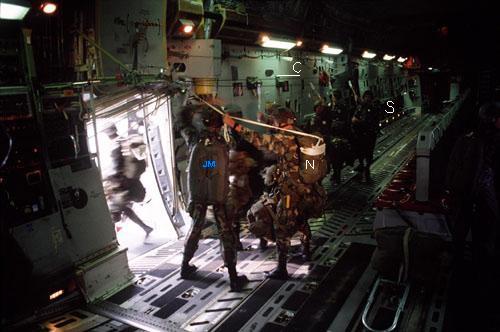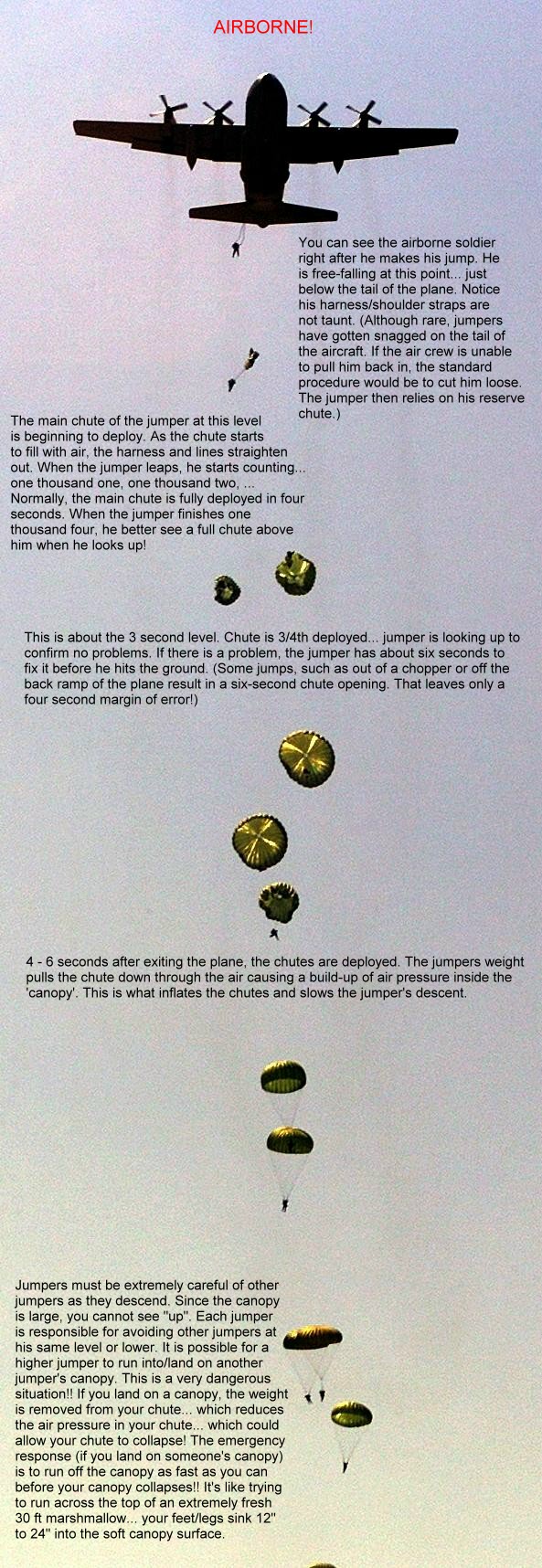You didn't have to be crazy to be in Special Forces... but it helped!
STAND IN THE DOOR!!
When we were in Training Group, we were required to make periodic parachute jumps in order to receive our $55 per month 'jump pay'. One day Bill and I were traversing the 'company area' and stopped to check the 'jump manifest'. (The 'jump manifest' was a list of SF'ers scheduled to make a parachute jump.) Sure enough... there were our names! Neither of us said much about the manifest... we were probably more interested in where we were eating that night. The day before the scheduled jump, Bill mentioned that he needed to run down to the "rigger's shed".
Note: The "riggers" were the men who packed the parachutes. These men would inspect the parachutes and, if everything was okay, would neatly, methodically, CAREFULLY fold the parachute into its pack. There was NO room for error here! One mistake "rigging" a 'chute and someone might die. The riggers had a tough, stressful job!!
I didn't think to ask Mack what he meant. In fact, I didn't think much about it at all. Within a couple days Mack and I found ourselves at Pope AFB... waiting to be loaded for our jump. Everything was normal... well, at least as 'normal' as could be expected when you have 60 SF'ers together. We were loaded into the C-130 and off we went.

In this photo the men are jumping from a C-17 aircraft. Note that only one door is shown. On most C-130 jumps there would be an open door on BOTH sides of the aircraft... opposite each other -- one exit door for each stick. The pilots do some calculations and determine where to drop the soldiers in order for them to land in the designated area called the 'Landing Zone'. This 'window of opportunity' lasts for a very short period of time. Therefore, it is important that all jumpers exit the plane in a short amount of time. It was common for us to unload two sticks of jumpers in less than 60 seconds once the green (jump) light came on! Of course, if someone tripped, confusion would prevail and the jump window would be missed. Therefore, we shuffled our feet... the'airborne shuffle'... to reduce the risk of tripping. One guy out each door every two seconds!!
But wait a minute...
I've got to explain what we did on jumps and how we did it. Otherwise, the next part won't make any sense. The men making
the jump were divided into two groups. Each group occupied a row of fold-down canvas seats along each outboard wall of the aircraft. Each of
these two rows were referred to as a 'stick'. Once loaded and seated, the men settled in for the ride. More about the ride later... The photo
to the left illustrates the seating arrangement. (I put a letter "S" on the photo to mark some of the seats.)
At the door-end of each stick stood a 'Jump Master'. (I put the letters "JM" on the man in this photo. His back is to the camera.) He was the
safety NCO... a seasoned jumper. His job was to make sure all members exited the aircraft... and safely, also. (I've seen them put a boot on
the back of a jumper and push the man out the door if he hesitated!)
The next man to jump is marked with a "N". Notice that he has made a 90 degree right turn and is now facing the door. Did you notice his left
hand? He is holding his 'static line'. (Pulling on the static line rips open the flaps that cover the main chute and allow it to deploy or
inflate.) The jumper had previously secured the hook at the end of the static line to the steel cable ("C" in the photo) that runs the length
of the aircraft's interior. After the jumper falls 15 or 20 feet (the length of the static line!), the static line becomes taunt and opens the
main chute. It is the static line that opens the jumper's chute!

Just like swimming, parachuting used the 'buddy system'. Checking equipment was (obviously!) an important part of jump preparation. You and
your buddy checked each other's equipment -- both on the ground AND in the air. In the picture above you can see the equipment checks. Did you
notice that the static lines are blue on these chutes? I've highlighted the various components: Rut sack, reserve, rifle, etc. Notice the two
guys partially lying down -- just below the word 'reserve'? They are lying down because, with all this equipment on, you can't sit very well!
The photo above copied from http://www.geocities.com/Pentagon/5265/T-21.htm
Jump Preparations
If this was an 'equipment jump', each soldier carried his (main) parachute on his back, a reserve or emergency 'chute on the front over the five-point release, a forty-pound 'rut sack', and a rifle strapped along his left side. Mobility was, to say the least, greatly impaired! The parachute harness was restrictive (and, in the wrong 'position' -- "uncomfortable!"), the rut sack blocked the natural bending movement of the knees, and the rifle (strapped vertically along your left side) meant it was very difficult to bend at the waist. (If this was a 'regular' jump, subtract the rifle and rut sack.) The rut sack is where you carried your supplies. Once you jumped and had descended to approximately 50 to 100 feet above the ground, you were supposed to pull the rut sack release. This would allow the rut sack to drop and hang below you... suspended on a rope about twenty feet long. With me so far???
Back to the story...
The ride: Most of the time we had to ride in the aircraft for three or four hours before we jumped.... HOURS! It was usually hot, frequently
bumpy, the men sweated... some even got air sick! Puke everywhere! The plane smelled terribly, the noise was deafening, and some of us were
nervous. Frankly, after four hours I wanted out of that plane!!
When it finally neared the time to jump, the Jump Master gave us the command: "Stand up!" (Because of the noise level, both voice and hand signals
were used.) The next command, "Hook up!", means "Snap the hook of your static line onto the aircraft's steel cable". Next came "Check
equipment!". You checked your equipment ...all connections made? ...straps tight? Turn to your buddy. Is his equipment okay? ...is he hooked
up to the cable? ...reserve handle readily accessible?? "Stand in the door!" is the next command. With that signal, the first man of each stick
would shuffle up, make the appropriate 90 degree turn, two more shuffles and actually stand in the open doorway -- toes dangling over the edge
of the door sill. Look down... it's usually 1200 feet below you... 120 stories! If your chutes don't open, it's "plane-to-ground" in ten seconds!
"GO!" is the final command. One after the other, each man in the stick quickly shuffles up, makes the turn... and leaps.
Well, on this particular day Mack was feeling a little devilish. When we got the 'Check equipment' command, Mack turned back to me and said:
'Take this' and slid his static line hook down the cable to me. I grasped BOTH static line hooks and stood ready to shuffle. Sure enough... I
saw the green light come on and the stick started moving.
Mack was ahead of me; leading the way... we were shuffling our little fannies off. Mack got to the door, reached out, handed the Jump Master the
'extra' static line hook, said "Here... hold this!", and exited the plane... me right behind him. You should have seen the look on the Jump
Master's face! It was pure panic!! As far as he knew, that jumper just exited the plane WITHOUT being hooked up! The Jump Master almost came out
of the plane trying to catch Mack while I was jumping. God, it was funny!!!!
They were waiting on Mack when he got to the ground. He almost got busted for that stunt. I'll never forget the look on the Jump master's face
when Mack said "Here... hold this!" and went out that door! The extra static line is why Mack went to the rigger's shed!
Close look at a parachute jump in progress

